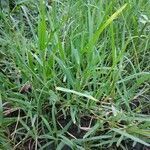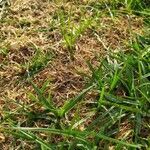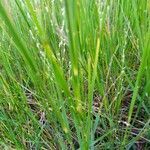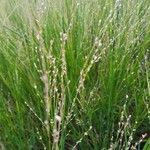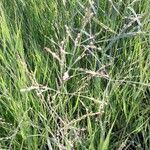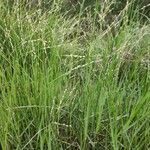Subglabrous perennial with long rhizomes and often also surface stolons; culms tough, erect or decumbent, 30–100 cm. high, often from a knotty base.. Leaf-blades linear, 7–25 cm. long, 2–8 mm. wide, flat or rolled when dry, often stiff and pungent, distichous, ascending close to the stem, acute or acuminate.. Panicle narrowly oblong, 5–20 cm. long, sparsely to moderately branched, the branches usually ascending.. Spikelets ovate, 2.5–3 mm. long, pale, often tinged with purple, acute; lower glume broadly ovate, 1/3 the length of the spikelet, hyaline, 1(–3)-nerved, clasping the base of the spikelet, obtuse or acute; upper glume ovate, as long as the spikelet, membranous, (7–)9-nerved, acute; lower lemma similar to the upper glume, male, its palea well developed; upper lemma pale and glossy.. Fig. 121.
Tufted perennial, up to 1 m high, hygrophyte to occasional hydrophyte, erect to decumbent, sometimes floating, rhizomatous, base maybe knotty; leaves mainly cauline. Leaf blade 70-250 x 2-8 mm, distichous, ascending, usually pungent. Inflorescence a 50-200 mm long, narrowly oblong panicle, sparsely to moderately branched, usually ascending. Spikelets 2-3 mm long, ovate-elliptic to ovate, dorsiventrally compressed; lower glume broadly ovate, 1/2 length of spikelet, 0-3-nerved; upper glume 7-9-nerved. Florets 2; lower floret usually male, lemma 7-9-nerved, broadest interspaces between nerves not confined to adjacent to central nerve, palea well developed; upper floret bisexual, lemma indurated, pale to yellowish, shiny, entire, margins only clasping edges of palea. Flowering time Oct.-June.
Tufted perennial to 1000 mm high; hygrophyte to occasional hydrophyte, erect to decumbent, sometimes floating; rhizome long; base sometimes knotty; leaves mainly cauline. Leaf blade 70-250 x 2-8 mm, obviously distichous, ascending, usually pungent. Inflorescence 50-200 mm long, narrowly oblong; sparsely to moderately branched, usually ascending. Spikelet 2-3 mm long, ovate-elliptic to ovate; lower glume broadly ovate, 1/3-1/2 the spikelet length, 3-nerved; upper glume 7-9-nerved; lower floret usually male, lemma 7-9-nerved, broadest interspaces between nerves, not confined to only those adjacent to the central nerve, palea well developed; upper lemma pale to yellowish, shiny.
Perennial, occasional hydrophyte, rhizomatous and tufted (erect to decumbent, sometimes floating), up to 1 m high. Leaf blades 70-250 mm long, 2-8 mm wide, leaves mainly cauline, distichous, ascending, usually pungent. Spikelets 2-3 mm long. Inflorescence narrowly oblong, sparsely to moderately branched, usually ascending; lower glume broadly ovate, up to half the length of spikelet; upper glume and lower lemma 7-9-nerved; lower floret usually male, lemma with broadest interspaces between nerves not only adjacent to central nerve, palea well developed; female-fertile (upper) lemma pale to yellowish, shiny.
Rhizomatous perennial, up to 1 m tall. Leaves linear, mostly cauline, often pungent; ligule a fringe of hairs or a fringed membrane. Inflorescence an open, narrowly oblong panicle; branches erect. Spikelets 2-3 mm long, awnless; glumes unequal, lower a third as long as spikelet, upper 7-9-nerved; 2-flowered, lower floret male, soft; upper floret fertile, lemma hard, pale, smooth and glossy.
Spikelets 2.5–3 mm. long, ovate-elliptic or ovate, acute, inferior glume 1/3 the length of the spikelet, broadly ovate or cuff-like, membranous, 0–3-nerved, clasping the base of the spikelet, obtuse or acute; superior glume 7–9-nerved; inferior lemma similar to the superior glume, male, its palea well developed; superior lemma and palea pallid, glossy.
A grass that keeps growing from year to year. It has rhizomes. The stems can be erect or bending over. They are 30-125 cm long. The leaf blades are 7-25 cm long by 2-8 mm wide.
Leaf laminae 7–25 cm. long and 2–8 mm. wide, linear, flat or involute, often strongly distichous and ascending close to the stem, usually stiff and pungent.
Perennial with long rhizomes and occasionally with surface stolons; culms 30–100 cm. high, erect or decumbent, tough, often arising from a knotty base.
Rhizomatous perennial to 1 m. Leaves mostly cauline, often pungent. Spikelets in an open panicle, narrowly oblong, 2-3 mm long, lower lemma 7-9-nerved.
Panicle 5–20 cm. long, narrowly oblong, sparsely to moderately branched, the branches usually ascending.
Rhizomatous perennial about 60 cm, high
